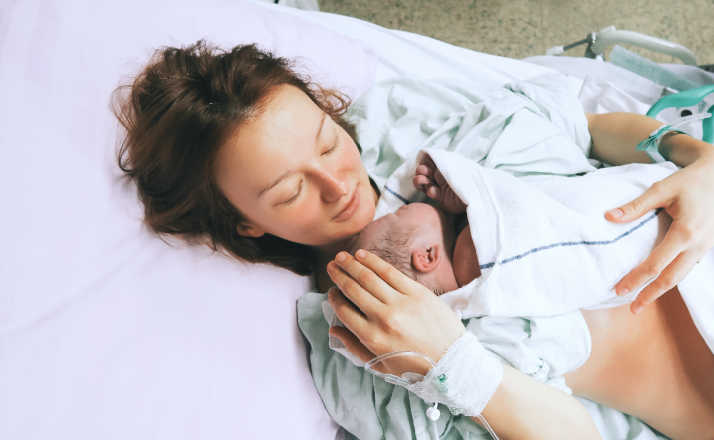After my first C-section, I wondered what I would do if I got pregnant again. How would I choose to give birth? My OB-GYN made it seem like I didn’t have a choice. She said just have another C-section. A VBAC wasn’t suggested.
When I asked her again, she told me with a sigh of exasperation,
“If you really want to have 4 kids or more, then yes, you could try for a VBAC. But if you’re going to have 2-3 kids, it’s not worth it.”
Wow, thanks Doc. (And yes, I did switch providers after that doctor showed just how unsupportive she was of VBACs.)
According to Mayo Clinic, 70% of women with one previous C-section will go on to have a successful VBAC (vaginal birth after Cesarean).
But if the number is so high, why are doctors (like mine) hesitant to allow patients to try for a VBAC?
VBACs only became a thing in the 1970s. Doctors used to say, “Once a C-section, always a C-section.” But in the 1970s, doctors started to notice the many benefits for women having a vaginal birth. There is less recovery time, less surgical risks, less scarring, etc.
One in three births in the United States are C-sections due to chronic health issues, placenta issues, prolonged labor, fetal distress (if the baby’s heart rate dips), the baby is in a breech or transverse position, and of course, the mom chooses to have one.
Can you have a VBAC?
The American College of Gynecologists (ACOG) approves of OB-GYNs helping pregnant women attempt a VBAC. The biggest concern for attempting a VBAC is uterine rupture, which is extremely rare, and happens in less than 1% of all births.
A uterine rupture could put the mom and baby in an emergency situation with risks like uncontrolled bleeding and oxygen deprivation.
But the biggest advantages of having a successful VBAC are shorter recovery, less chance of blood clots, internal bleeding, infection, and lower potential risk for future births.
So what are we C-section mamas supposed to do? What if we want to try a vaginal birth?
Here are some steps I took while planning for mine:

Find out your risk factor(s)
A key part of having a successful VBAC is knowing why you needed your first C-section. For instance, if you went into labor and stalled or the baby got stuck in the birth canal, or other issues during labor itself, you may be considered a higher risk VBAC patient.
If you chose a C-section for personal reasons or your baby was breech, you’ll most likely be a lower-risk patient for a VBAC.
Understand what a TOLAC is
Let’s say you’re cleared by your doctor to try for a VBAC. They’ll probably call it a TOLAC (trial of labor after Cesarean). The TOLAC means they’ll put certain limits on your labor like when you go, how long, what induction methods are allowed, etc.
Get multiple opinions
Some OB-GYNs may not be comfortable with VBACs based on their own personal experience or opinion, even though TOLACs are deemed safe by ACOG and other healthcare groups.
Ask for a second opinion if your OB-GYN flat-out refuses to consider a VBAC. Or ask for a referral to a maternal fetal medicine specialist. They deal with high-risk pregnancies every day.
Make a realistic plan
Every woman who gives birth has some kind of plan. Planning for a VBAC is just extra special because you can only use certain induction methods and medical interventions.
Also, as you plan your VBAC, you might consider hiring a birth doula or a midwife to support you during labor (I did both). It never hurts to have extra support.
As a midwife and author, Ina May calls it: Make your own team “birth bubble.” This can include joining a VBAC support group on Facebook or joining your local ICAN (International Cesarean Awareness Network) chapter.
While making a VBAC plan, you should mentally prepare yourself for both outcomes — the vaginal birth and C-section birth. You can still hope for the VBAC you want, while staying realistic and knowing that a repeat C-section is possible.
Be prepared for the plan to change
I scheduled a C-section for my first baby because she was breech. This made me a low-risk and excellent candidate for a VBAC. During my second pregnancy I worked out, ate healthy, saw a pelvic floor therapist and a chiropractor, and I even switched OB-GYNs three times to find the right one.
I labored for over 24 hours, but my intended VBAC ended with an emergency repeat C-section.
Of course, I was very disappointed. But I learned a valuable lesson. It’s always good to advocate for your health.
By researching and attempting a VBAC, I learned more about my bodily autonomy during pregnancy and healthcare in general.
I also learned all sorts of fun things. For example, the GBS screening you get in your 3rd trimester (Yes, the one where they swab your vagina and anus), you can do yourself! You don’t need to have the doctor do it.
If you hate drinking that glucose drink for the gestational diabetes test, you can measure your own blood sugar at home. (As long as you don’t mind pricking your finger three times a day).
You can take ownership of your health — and you can always ask why something is happening and ask for an alternative treatment method.
Let’s ask questions and advocate for our health. Whether you choose to attempt a VBAC or you choose a repeat C-section, make the best, informed decision for YOU.











